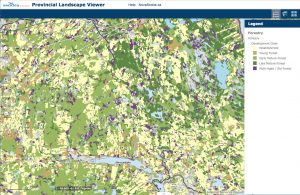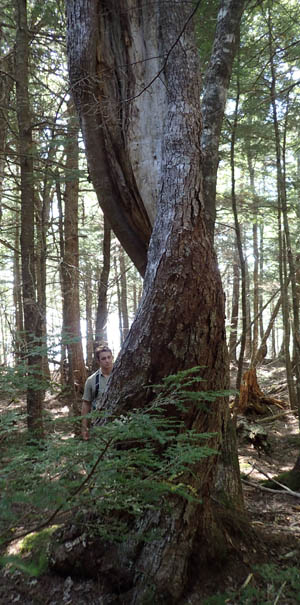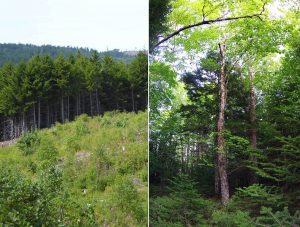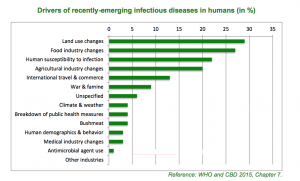
Extensive clearcutting over much of NS – which is 75% forested, down from probably >90% in pre-Columbian times – has ensured survival of early succession forest species but has come at the expense of old forest species and of species requiring large areas of intact forest. It has also reduced carbon storage in the trees and in the soil, thereby contributing to global warming. It also alters hydrological regimes and reduces other ‘Ecological Services‘, and may even have contributed to spread of lyme disease. Surely it is time to put Humpty Dumpty back together again.
To Randy Delorey, Labi Kousoulis and Iain Rankin, Nova Scotia MLAs and Candidates for leadership of NS Liberal party/Premier of Nova Scotia, to be elected on February 6, 2021 :
I ask you to give some serious thought to this question. I invite you to respond and if you do, I will post your response on NS Forest Notes. No limits on length. I know this is a difficult one to address. Please let me know soon if I can expect a response, and more or less when (I will add a note announcing the expected response at the top of this post.)
Thx,
David P
Nova Scotia Forest Notes
(e-mail sent)
——————-
UPDATE Jan 4, 2020: Received from Labi Kousoulis: “Thank you for posing this question as it’s a very important question that does need to be addressed. A Kousoulis government will work with federal counterparts to ensure both governments are aligned on this subject. As leader, I will expect my minister responsible, to have an open dialog with the federal counterpart responsible. The environment does not adhere to political boundaries, meaning we all must work together to preserve what we have. View Full Response
——————
original post continues:
I am offering a few numbers from a previous post on this topic, below, to help inform your responses.
Prime Minister Trudeau recently announced that Canada would join Britain and the EU in committing to 25% Protected Area by 2025 and 30% by 2030.*
___________
* View a Brief History of PAs. NS is currently at 12.72%. Canada achieved 12.1% of its terrestrial area (land and freshwater) and 13.8% of its marine territory conserved by the end of 2019. For terrestrial protection, the global average is 15.2%, and amongst individual countries, we rank # 127, hardly a number to brag about especially given so much of Canada is not settled. Less than 3% of the ocean is effectively protected globally, so we are doing better on that front – but we are still a long way from 30% on both land and sea.
Thirty percent is a big jump from where we stand today, but in fact 30% is at the lower end of the best estimates by conservation experts. A review prepared as background for the upcoming negotiation of the post-2020 Framework for Biodiversity under the Convention on Biological Diversity concludes
#1 “The 17 per cent terrestrial and inland waters, and 10 per cent marine and coastal targets from Aichi Target 11 of the Strategic Plan for Biodiversity 2011–2020 are not adequate to conserve biodiversity”
#4 “The global protection of a minimum of 30 per cent and up to 70 per cent, or even higher, of the land and sea on Earth is well supported in the literature. The call for 50 per cent of the Earth is a mid-point of these values and is supported by a range of studies.”

Objectives:
(i) the conservation of biological diversity;
(ii) the sustainable use of the components of biological diversity;
(iii) the fair and equitable sharing of the benefits arising out of the utilization of genetic resources.
The review underscores the importance of simultaneously addressing both biodiversity targets and “nature’s contributions to sustaining people (ecosystem services including carbon storage)” as agreed upon under the Rio Convention on Biodiversity in 1992/3 and the Aichi Targets (2010).
The Global deal for Nature proposes that we formally protect 30% of the landscape, AND manage an additional 20% as “climate stabilization areas” by 2030 (View Post Nov 23, 2019)
We might get by on the lower end of this range if a lot of effort were put into the quality of protected sites, also to target sites for most effective conservation and carbon storage value (versus simply conserving the most readily available sites such as sites not sought for economic use). For Canada as a whole, for example, the boreal forest is clearly important:
Canada’s boreal forest is one of the largest and most intact ecosystems on the planet. It is a vast storehouse of carbon, and hosts a breeding bird population of 1–3 billion. The boreal forest’s Woodland caribou are highly sensitive to human disturbance and a keystone species. They are a good example of a species-based tipping point. It has been calculated that at least 65 per cent of a boreal caribou range should remain undisturbed to provide a 60 per cent probability of retaining Woodland caribou in the system (Environment Canada, 2011). As with the Amazon, a very high retention figure is needed to maintain even basic values in this large ecosystem. Woodley et al., 2019
What about Nova Scotia? We are a peninsula physically mostly separated from the rest of Canada, with a large coastal influence, diverse bedrock and surficial geology and high biodiversity with a number of species found in NS but not elsewhere in Canada. So the rest of Canada cannot do the job for us.

Old trees support biodiversity and store carbon. Raymond Plourde spotted this old, wind-twisted red maple during a hike through Old Forest by Sandy Lake (Bedford, N.S.) on Sep 15, 2019. When such trees – not usable for lumber – are harvested in clearcuts, we lose old forest biodiversity. Typically they are chipped for burning, instantly releasing all of the tree’s stored carbon as atmospheric carbon dioxide and contributing to global warming.
In fact we’ve known since Karen Beazley and associates at Dalhousie University published a paper in the prestigious journal Ecological Applications in 2005 on “Biodiversity considerations in conservation system planning: a map-based approach for Nova Scotia Canada” that we need to protect at least 32% of the land in NS and manage a full 60% of our land base for conservation to to maintain genes, species, and ecosystems over time.
So, how do we get to 30% from 13%?
Some choices, each option with tradeoffs, will have to be made. Just considering the area target alone (not how the areas are targeted or quality of sites), the first question is whether the increase is achieved on public or private land, respectively constituting approximately 38% and 62 % of the land area in NS (5,525,014 ha).
Given how Nova Scotians feel about the sanctity of private lands, it’s unlikely that we would get very far trying legislate protection on private lands. The Nature Conservancy of Canada and the NS Nature Trust are the major agencies acquiring private lands in NS for protection and are strategically focussed on smaller sites of high conservation significance (NS Nature Trust approx. 6000 ha, NCC approx 14,500 ha) – these are very important and the biggest bang for the buck, but most are not large area-wise.
That leaves the Crown lands to bulk up the percentages. By my back-of-the envelop estimates based on data from the 2016 State of the Forest Report, and in the High Production Forestry Discussion Paper, 30% Protected by 2030 would require circa 74% of Crown lands that are not now protected to be protected and most of it would have to come from forested lands which make up 75% of our landscape. (See Land Base on this website for details.)
That would significantly reduce the Crown lands available for forestry, by my calculation to at best 310,998 ha of working forest down from approximately 687,000 ha.
Both to protect old forest biodiversity (currently greatly diminished by extensive clearcutting) AND maintain a high level of carbon storage in our forests, new protected areas would have to include a large component of existing old forest such as exists in the biodiverse lands of SW Nova Scotia. A large chunk of those lands was purchased by the people of NS in 2012 with expectations that conservation and sustainable forestry – not plantations – would be a priority.
————
So How about it, Iain Rankin, Labi Kousoulis and Randy Delorey – How do you plan to align Nova Scotia with the federal Liberals commitment to 30% Protected Area by 2030? 2Jan 2021
– Do you accept that commitment on the behalf of Nova Scotia?
– How do you plan to achieve it, and how do you see that impacting the now long delayed implementation of the Lahey recommendations?
You might note that Bill Lahey in his report of 2018, viewed the protection leg of the Triad as incomplete (bolding inserted):
Conclusion 31: For the triad model to be successful, all three of its elements must be taken seriously. Nova Scotia has most clearly taken the protection leg of the triad seriously, having almost reached its goal of having 13 per cent of the province reserved as protected areas, perhaps because of the support wilderness conservation received from the Environmental Goals and Sustainable Prosperity Act. The work to be done on this leg of the triad is, however, unfinished. Canada’s commitment to protecting at least 17 per cent of its land and fresh water, and the ecological rationale within a triad framework for protecting lands representing more than 13 per cent of Nova Scotia, should include ongoing development of the province’s network of wilderness areas, nature reserves, parks, and privately conserved lands.
On Canada’s commitment to 17%, Lahey was referring to Canada’s 2010 commitment
“to a set of 20 targets known as the Aichi Targets established under the Convention on Biological Diversity. Target 11 commits parties to an aspirational goal of protecting at least 17% of terrestrial and inland waters and 10% of coastal and marine areas by 2020.” -view comprehensive ENVI COMMITTEE REPORT (House of Commons)
Now Canada is committing to 30% Protected Area by 3030, so how will a NS Liberal government under your leadership participate in this commitment ?
SOME RELATED POSTS & LINKS
Plourde urges Premier to reset the agenda on nature for Nova Scotia 13Oct2020
Post on NSFN, Oct 13, 2020
Biodiversity & Infectious Diseases – Questions & Answers
Prepared May 21, 2020 by the World Health Organization and the Secretariat of the Convention on Biological Diversity under their Joint Work Programme on biodiversity and health.
Could forest fragmentation be a factor in the high incidence of blacklegged tick/lyme in Nova Scotia?
Post on NSFN June 16, 2018
30 by 2030: Ten Things you Should Know About Canada’s New Protected Areas Targets
Post on Ontario Nature, Oct 30, 2020. A good summary of why it’s important. Of note: “The targets are not solely about protecting places. Significantly, they include commitments to respect and promote Indigenous participation, knowledge systems and cultural practices in decision-making.”
Canada joins Britain, EU in plan to stem ‘catastrophic’ biodiversity loss by 2030
By Kate Abnett Reuters posted on Global News Sep 28, 2020.
What can Nova Scotia do to preserve nature and encourage biodiversity?
On CBC Mainstreet. View Abbreviated Transcript & Notes here. “Canada has committed to protect 30 per cent of our lands and oceans by 2030, with an interim goal of 25 per cent by 2025. Host Jeff Douglas spoke with Megan Leslie from the World Wildlife Fund and Raymond Plourde from the Ecology Action Centre about why this is a big deal and what Nova Scotia can do.”
Moving Beyond Lahey: can Nova Scotia participate in a “Global Deal for Nature”? 14Dec2019
Post on NSFN Dec 14, 2020
Teens tell Nova Scotia government climate targets aren’t good enough
By Taryn GrantStar Halifax Oct 28, 2019 “The new bill [the Sustainable Development Goals Act] proposes reducing greenhouse gas emissions to 53 per cent below 2005 levels — for a total of 11 million megatonnes — by 2030, and to net-zero by 2050. While many of the presenters said they were glad to see steps being taken to address climate change, none were satisfied with the targets.
Cost-effective priorities for the expansion of global terrestrial protected areas: Setting post-2020 global and national targets
Rui Yang et al. 2020. Science Advances 09 Sep 2020 “Biodiversity loss is a social and ecological emergency, and calls have been made for the global expansion of protected areas (PAs) to tackle this crisis. It is unclear, however, where best to locate new PAs to protect biodiversity cost-effectively. To answer this question, we conducted a spatial meta-analysis by overlaying seven global biodiversity templates to identify conservation priority zones. These are then combined with low human impact areas to identify cost-effective zones (CEZs) for PA designation. CEZs cover around 38% of global terrestrial area, of which only 24% is currently covered by existing PAs. To protect more CEZs, we propose three scenarios with conservative, moderate, and ambitious targets, which aim to protect 19, 26, and 43% of global terrestrial area, respectively. These three targets are set for each Convention on Biological Diversity party with spatially explicit CEZs identified, providing valuable decision support for the post-2020 global biodiversity framework.”

Two approaches to forest management in Nova Scotia: LEFT: even aged management/short rotations. RIGHT: Selective harvesting, high standing volume and structural integrity is maintained. The latter but not the former would be eligible for carbon offset credits, which could make it the more attractive option for many small woodlot owners in NS, especially those with high volume/older forest stands.
Protecting supply of “wood” but not necessarily big trees from Nova Scotia’s Crown lands remains the priority at L&F 15Mar2020
Post on NSFN Mar 15, 2020
Nova Scotia municipalities lead the way in addressing climate and biodiversity crises, L&F Please follow! 26Sep2019
Post on NSFN Sep 26 2019
Dale Prest on “Climate Forests”
Post on NSFN May 4, 2018
Upgrading protected areas to conserve wild biodiversity
Robert M. Pringle in Nature, 2017, Vol.546(7656), p.91 “International agreements mandate the expansion of Earth’s protected-area network as a bulwark against the continued extinction of wild populations, species, and ecosystems. Yet many protected areas are underfunded, poorly managed, and ecologically damaged; the conundrum is how to increase their coverage and effectiveness simultaneously. Innovative restoration and rewilding programmes in Costa Rica’s Área de Conservación Guanacaste and Mozambique’s Parque Nacional da Gorongosa highlight how degraded ecosystems can be rehabilitated, expanded, and woven into the cultural fabric of human societies. Worldwide, enormous potential for biodiversity conservation can be realized by upgrading existing nature reserves while harmonizing them with the needs and aspirations of their constituencies.” PDF
Opinion: Cultural and linguistic diversities are underappreciated pillars of biodiversity
André Frainer in proceedings of National Academy of Science Oct 7, 2020 “Recent studies reveal how cultural and language diversities are intrinsically linked to the protection of biological diversity. Some of the largest countries on Earth, including Canada, Brazil, and Australia, are home to hundreds of languages and cultures, many of which are endangered. But the Indigenous-controlled lands represent only 6% and 13% of the territory in Canada and Brazil, respectively, and 52% in Australia. Still, these indigenous-controlled lands typically contain much higher biological diversity than that found in non–Indigenous-controlled areas, both protected and nonprotected, in the same countries .”
British Columbians want more parks, even if it means less mining and logging: survey
Liam Harrap in revelstokereview.com Oct 21, 2020 “Four out of five British Columbians would support the B.C. government creating more protected areas with Indigenous peoples, according to a recent survey. The survey, conducted by Insights West, found 80 per cent of people in B.C. support increasing environmental protection, even if it meant reducing areas available for mining and forestry.”
Extracts from Jim Vibert: Mother Nature’s on the run in Nova Scotia
The McNeil government’s signature environmental achievement is the closure of Boat Harbour. Unfortunately, it’s also pretty much its only environmental achievement.
After all, this is the government that was found to be in contravention of the province’s endangered species …While that was a breathtaking dereliction of duty, it’s debatable whether it tops the list of environmental sins of omission and commission…
In 2013, the Liberals were elected after pledging to protect, at a minimum, 13 per cent of the province’s land for nature. Seven years on, and they still haven’t achieved that very modest target.,, Nova Scotia’s parks and protected areas plan was complete — following years of consultation and consideration — when the Liberal government arrived, All they had to do was designate those places as parks and protected areas and — Bob’s your uncle — they’d achieve their promised 13 per cent.
…these same Liberals surreptitiously delisted the designated park at Owl’s Head to make way for a golf course development.
During the 2017 election campaign, the McNeil Liberals promised Nova Scotians a law to conserve Nova Scotia’s biodiversity.
It’s more than a little telling that the Liberals alternate between environmental activists during election campaigns and environmental scofflaws once they’re safely in government.
….true to their word, they brought in a bill in 2019 “to provide for an integrated framework of legislation that supports the stewardship, conservation, sustainable use and governance of biodiversity in the Province” — otherwise known as the Biodiversity Act.
…However, it stalled on its way to becoming a law when it bumped up against some vested interests and now it remains marooned on the legislature’s order paper, unpassed to this day.
…finally, there is Bill Lahey’s much acclaimed — and properly so — report on sustainable forestry practices in Nova Scotia.,, the McNeil government subsequently accepted and promised to implement.
Except to date, much of the report gathers dust, while the government plows ahead with that part that permits so-called industrial forestry (clearcutting) on Crown lands.
& Candidates, please consider this comment about cutting on Crown land this a.m.
i dont care what the treatment no crown wood should be cut until DNR opens the books and tells the people of NS how much we the tax payers will make from the sale of are trees. watching loads of random length hardwood off crown roll past all the time cut to 8 foot fire wood it would be worth 80$ a cord as fire wood cut to random length its must be sold by the tone at a loss of somthing like 20$ a cord chipped and exported or burned for biomass . watched contractors on crown this summer pile up the nicest of there hardwood logs only to burry them in gravel and waste them in the fall with there subsidized road building a pile of random length next to it was junked and stolen buy people trying to stay warm .no other gov asset could be handed out with no bid or tender and wasted so blatantly…a few years ago a oxford blueberry prosesser was sucsesfully suied by farmers for colluding with agi dep and running a monopoly in the fishing industry the fishermen have fleet and prosessor seporation at dnr they meddel in the free market and subsidze mills walking a fine line on lossing are tariff protection how did the layhe reviw miss the economics so badly ?

